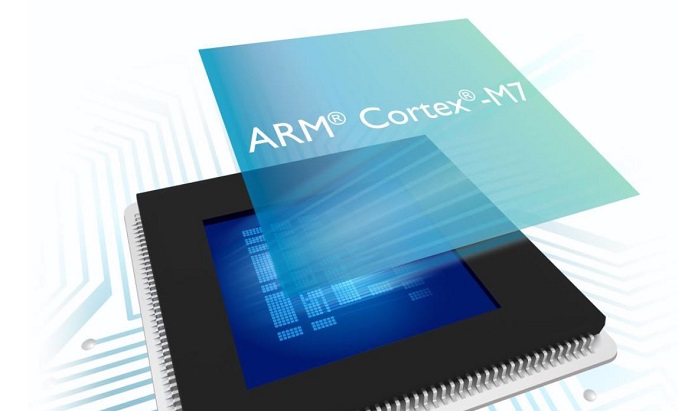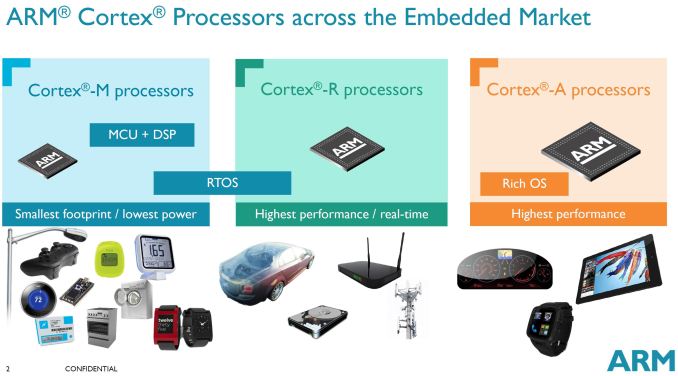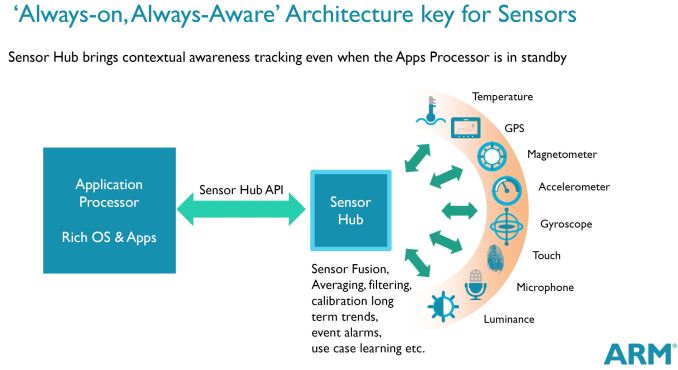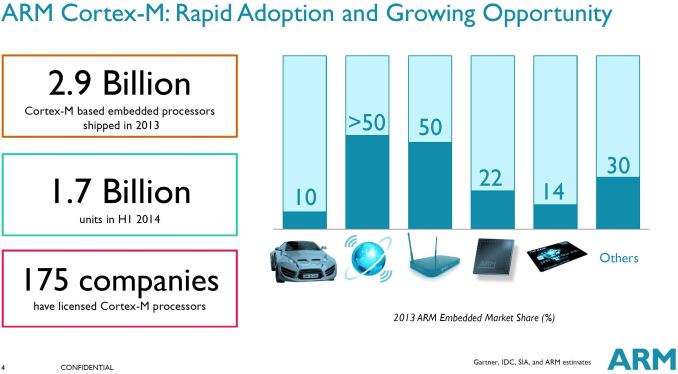Cortex-M7 Launches: Embedded, IoT and Wearables
by Stephen Barrett on September 23, 2014 7:01 PM EST
Introduction
Last week, I had the distinct pleasure of visiting ARM’s Austin Texas campus for a meeting with Vice President of CPU Product Marketing Nandan Nayampally. The topic of discussion: ARM’s next Cortex-M processor, codename Pelican, is officially launching today as the Cortex-M7. Thankfully, unlike the A series CPU cores mobile device enthusiasts have grown to love, M and R series cores are typically announced at the same time as retail availability from ARM’s customers. ARM has therefore been working with lead semiconductor partners for some time, and their fully integrated products should have similar launch announcements soon.
If you are not familiar with the M and R series processors from ARM, I don’t blame you. These microcontroller processors don’t receive quite the coverage as A series application processors like the A7, A9, A15, A53 and A57 do. Considering my own heritage learning about PC technology, this is understandable. I always wanted to learn about the latest processors from AMD and Intel as these most directly related to my productivity and entertainment. However, if the smartphone wave was any indication, the next decade of productivity and entertainment might come from processors we don’t expect or even know about.
Fundamentally, the M series processors are considered microcontrollers and not application processors, mainly because they lack a memory management unit (MMU). An MMU’s primary role is to sit between the processor and memory, intercepting all memory references and performing translation between virtual addresses and physical addresses. General purpose operating systems such as Linux (Android), Windows, OSX, and iOS require an MMU to function. That means M series processors, like all microcontrollers (MCUs), will never be tasked with running general purpose operating systems.
MCU proliferation is actually already happening today. Nandan mentioned that a device containing a single R or A series processor might also contain dozens of Cortex-M processors performing a variety of tasks that make your life better. Nandan couldn’t mention any specific implementations, as he deferred to ARM's customer’s for that, but everything from smart thermostats, simple smart watches like the Pebble, and IC power management units are implemented with low power microcontrollers.
Even features we love on our high powered smartphones such as Microsoft’s Lumia Glance Screen and SensorCore, Motorola’s Moto Voice and Moto Display, and the iPhone’s Motion Coprocessor cannot be directly attributed to bigger faster application processors but rather come from MCUs, and arguably they have just as big an impact on our lives as a lower Sunspider score.
Looking at ARM’s track record in the past five years, one can easily correlate their success with the smartphone craze started with the original iPhone containing an ARM11 processor. From there, the 3GS upgraded to a Cortex-A8, 4S used the Cortex-A9, and Google attacked the same market with Android supporting the ARM11 and subsequent ARM cores as well. While ARM’s meteoric rise might have started with the ARM11, it was years of prior work that provided a solid foundation for partners and customers. In fact there were 11 cores released prior to the ARM11 (fancy that), including six revisions to their instruction set.
ARM has been investing in the Cortex-M line since 2004, when they first released the Cortex-M3. For a decade, ARM has been combating 8-bit and 16-bit microcontrollers with their 32-bit M series. With the release of the M7, ARM feels they have a very complete microcontroller lineup and have effectively “crossed the chasm” into the mainstream. The competition continues today, but with eight billion (yes, with a b) processors shipped to date containing at least one Cortex-M core, the M series is higher volume than all other ARM cores combined. In the first half of this year alone, ARM’s partners have shipped 1.7 billion Cortex-M units, where a unit is defined as a chip containing at least one Cortex-M processor.
Responding to market demand for powerful voice, sensor, display, and control offloading, ARM brings a higher performance, feature rich core to the Cortex-M family with the M7.













43 Comments
View All Comments
nathanddrews - Wednesday, September 24, 2014 - link
For as often as my phone, computer, stove, and microwave all get out of sync, you'd think we humans haven't yet mastered the whole "tracking of time" thing. Most of my devices are supposed to auto-update online, but that doesn't excuse the poor time-keeping of modern devices in between updates. Smart watch? Doubtful.markmuehlbauer - Wednesday, September 24, 2014 - link
Good point. 2014 and where are standards for this across all devices? The only devices that are truly accurate subscribe to a network time protocol (NTP) service.How about we recycle amplitude modulated carriers toward a narrow band digital signal broadcast NTP service. Then every device out there can have a simple AM loop antenna in it to "listen" to the NTP service and update. Of course this would require the FCC and IEEE to actually work together. Sigh. . .
otherwise - Wednesday, September 24, 2014 - link
There are already at least two ways to get a reference timestamp over the air. First is GPS, which will get you accurate timestamps into the sub-millisecond domain, which is why you see GPS devices in data centers usually as a stratum0 NTP device and/or a PTP Master. The second is WWVB operated by the NIST, which broadcasts reference timestamps at the 60KHz band. If you have an alarm clocks that sets itself this is probably the source it uses.makerofthegames - Tuesday, September 23, 2014 - link
So for my own understanding of roughly how powerful these are, what x86 processor would you say they're most comparable to? From the general architecture they look like a first-gen P5 Pentium, minus the MMU (and optionally minus the cache and FPU). Would that be an accurate analogy?jdesbonnet - Tuesday, September 23, 2014 - link
It's hard to directly compare MCUs to application processors. They have different types of tasks. Application processors are about computational throughput and you pay for that in enormous gate counts (=area=cost) and energy consumption. Eg the quad core Intel Xeon I'm using right now has a gate count in excess of 2G gates. By comparison a small Cortex M0 will have as few as 12K gates and can run tasks such as wireless security sensors for years on end from a single coin cell battery. Also MCUs facilitate deterministic code execution where timing of events is critical (eg detect car crashing -> deploy airbag). For benchmarks look a this table: http://en.wikipedia.org/wiki/Instructions_per_seco... Seems a ARM Cortex M0 at 50MHz is somewhere between an Intel 486DX and the original Pentium.makerofthegames - Tuesday, September 23, 2014 - link
Yeah, it's never going to be an exact comparison. I pulled the P5 guess from the architecture - both P5 and M7 are in-order, two-issue superscalar with two main integer paths and an FPU. And while their goals were very different, they both were very constrained for transistors (by current standards), so I figured they might have some level of comparison.wetwareinterface - Wednesday, September 24, 2014 - link
the nearest comparison to an x86 processor is the new intel edison. however where this will excel at certain tasks the edison will excel at others.to break it down any task that is memory bandwidth constrained will be better on edison.
any task that is latency critical and served best by an interrupt (the car crash airbag analogy above serves well) is better performed on the m7.
any task that is math based, requires simple calculations, and parallel execution or reordering on the fly of the task being performed is done frequently then the m7 would be a good choice with the inclusion of the dsp. an example of this is manipulation of incoming audio or video data in response to user input (examples like a guitar pedal for audio or video mixing effects like on a club's screens).
the simple fact is there's no perfect "one solution".
what one does better the other does worse and no processor is best in all catagories
Stephen Barrett - Wednesday, September 24, 2014 - link
edison isnt so much a processor as it is a SoM or system on module. It contains an atom silvermont applications processor (AP) and an Intel Quark microcontroller (MCU).HardwareDufus - Tuesday, September 23, 2014 - link
hmmm.. they are a risc based architecture (armv7 ISA), so they wouldn't have as high as an IPC as a cisc based architecture like pentium. however this cortex-m7 mcu is more a soc than just a straight processor like the pentium was. hard to say as the workloads are so absolutely different.BTW, with the embargo lifted.... ARM just updated their website:
http://arm.com/products/processors/cortex-m/cortex...
http://arm.com/Cortex-M7-chip-diagramLG.png
will be exciting to watch some of the initial development & prototyping boards introduced by some of the big players (ti, stmicroelectronics and atmel) to see what native capabilities they break out.
hopefully ethernet, sdio, jtag, and multiple channels of uart, can, spi, i2c/twi, dac are givens. would love a basic lcd interface too.
Wilco1 - Tuesday, September 23, 2014 - link
No, by definition RISCs have better IPC than CISCs, not the other way around (on a RISC pretty much every instruction executes in a single cycle, unlike the complex CISC instructions). Studies have shown x86 and ARM actually do the same amount of work per instruction due to x86 compilers avoiding the complex instructions (this observation is why RISC exists!), and ARM doing a lot of work per instruction (compared to other RISCs - such as allowing shift+add as a single instruction, conditional execution, load/store multiple). This effectively means any IPC difference is not due to ISA but due to microarchitecture.Looking at the Dhrystone results, the M7 is a bit faster than A7, so should obliterate Quark, beat an old Pentium and do well against Silverthorne at similar frequency.